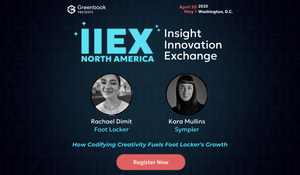Neurodiversity: Learning to drive methodological innovation in research
This piece was featured on Quirk's Media
“Neurodiversity may be the birthplace of some of humanity’s greatest minds.” – Harvey Blume
Along with the de-stigmatization of mental health struggles, neurodiverse experiences have come to the fore as a topic and a true expression of self that can and should be celebrated and talked about openly. People who experience the world in neuroatypical ways have shared with us the way they want others, society, and even brands to respond to and reflect on their experiences – that their minds and lives are creative and inspiring and sources of deep insight that can transform the way we do research, as well as the way we relate to others.
In a study on day-to-day workplace experience, we had respondents who inhabit the world with dyslexia, autism, and ADHD, talk about the difficulty of being in an office environment where norms around communication format, small talk, and the office environment itself make it difficult to navigate their professional lives. Learning from this experience transforms what it means to be in working relationships, what the work process looks like, as much as the work itself. In another study on self-expression in fashion, we had one individual talk about the rainbow toe socks that they felt were a quirky and deeply meaningful expression of both their neuroatypicality and their queer identity, and the judgment they’ve felt in being seen in these socks that they love. Fashion, then, becomes a place to learn about deeply rooted identities, creative flair, and the articulation of the mind itself in everyday aesthetic expressions.
From larger, more widely legible struggles to smaller experiences that may not seem as high stakes but which matter so much, neurodivergent or neuroatypical differences have been underappreciated and recognized in society and the unique challenges of qual research design and analysis. It’s also about - frankly - doing better and richer research.
Pushing back against this marginalization and silencing, respondents in our studies are increasingly proudly identifying themselves as neurodivergent and/or neurotypical, and calling out ways that normative modes of communication can be stifling and ineffectual. In turn, this has shaped the most basic nature of our communication with our participants. The environment of private messaging allows them to express themselves freely in conversation that doesn’t require direct eye contact, being in the physical presence of a stranger, or picking up on social cues that distract from the task at hand. They revel in having the time and space to share their experiences and feelings in a self-paced and completely open-ended context. There’s the opportunity to pause, reflect, walk away, and come back to the conversation at any time. There’s the opportunity to use any words – what might feel to respondents like the wrong words in the moment – and then work out the fuller expression of their experience on their terms.
Being attentive to neurodivergent experience is not only a matter of inclusion and appreciation of a broader spectrum of diversity; it’s a radically different way of thinking about the mind, knowledge, and qual research itself. Learning from neuroatypicality goes beyond efforts to “accommodate” or “appreciate” the neurodivergent experience; it’s about letting the radical alterity of being human wash over us as researchers and change the way we do qual research at a more fundamental level. The power of neurodiverse minds – whether our own or others – is in the spark of innovation, of free-thinking, of looking at a subject or problem from an angle we’ve not considered. That deepens our understanding and the way we try to know others in our research.
We have three suggestions that fuse the project of creating a safe and productive space for neurodivergent and neuroatypical respondents to share with us in a deeper and more personally resonant way with the inspiration and surprising insights we encounter in the process:
Create a non-confrontational environment. It can be difficult for people who experience autism, ADHD, and other forms of neurodivergence to articulate themselves quickly and deeply in more traditional qual environments (1:1 IDIs, focus groups, etc.). These interactions' social dynamics, social cues, and overall pressure can stilt conversation and put undue pressure or stress on respondents. Whether it’s the freeing environment of private chat or another way of offering prompts that allow for private reflection and response in a self-paced way and in a format that resonates most with individuals, getting away from traditional methodologies will be more inclusive and get richer responses from all respondents. Analyzing these responses, you can notice the inspiration that comes – not just in the content of the results but in the interactions themselves.
Offer a mixed media array of prompts. Everyone - those who are neurotypical or neuroatypical processes and expresses themselves differently. Some flourish is being able to write long, reflective responses – a sort of info dump. Others think first in visual ways as a springboard for text-based explanations. Others find music to be the most resonant access point to describe their feelings and experiences. Offering an array of mixed media prompts creates an environment where people can choose the most expressive and resonant methods and help us, as researchers, understand and connect to respondents’ experiences. This increases our own sensitivity and thus, allows for more holistic analysis and understanding of the topics we study, enlivening the research process as well as what flows from it.
Create a range of fully open-ended (and direct) questions. Asking a single direct question can resonate well with some individuals, but for others, a single question might not spark the kind of in-depth reflection we strive for in qual research. Offer multiple, fully open-ended questions to ensure that at least one of the questions can directly resonate with every respondent, giving something to inspire and anchor their experience and expression of it. It’s important to be direct and clear in question creation, but also create space for interpretation, self-inquiry, and ‘ah ha’ moments. This might elicit long, seemingly meandering responses, but appreciating the thought process behind an answer is just as important as the answer itself. As researchers, we’re changed in the process of considering more fundamental aspects of research design and what it means to connect and resonate most with the respondents whose knowledge and wisdom ignite our own.



